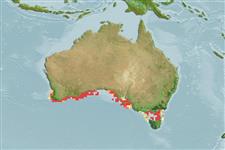Teleostei (teleosts) >
Eupercaria/misc (Various families in series Eupercaria) >
Odacidae (Cales and weed-whitings)
Etymology: Siphonognathus: Greek, siphon = tube + Greek, gnathos = jaw (Ref. 45335).
More on authors: Quoy & Gaimard.
Environment: milieu / climate zone / depth range / distribution range
Ecology
Marine; brackish; reef-associated; depth range 1 - 18 m (Ref. 75154). Subtropical; 32°S - 42°S
Eastern Indian Ocean: southern Australia, from Fisherman Islands, Western Australia to Portland, Victoria; including the Furneaux Group and the Tamar River Estuary in northern Tasmania.
Size / Weight / Age
Maturity: Lm ? range ? - ? cm
Max length : 18.0 cm SL male/unsexed; (Ref. 6185)
A benthic species (Ref. 75154) which is common in soft bottom communities with seagrass.
Life cycle and mating behavior
Maturities | Reproduction | Spawnings | Egg(s) | Fecundities | Larvae
Gomon, M.F. and J.R. Paxton, 1985. A revision of the Odacidae, a temperate Australian-New Zealand labroid fish family. Indo-Pac. Fish. (8):57 p. (Ref. 6185)
IUCN Red List Status (Ref. 130435)
Threat to humans
Harmless
Human uses
Fisheries: of no interest; aquarium: commercial
Tools
Special reports
Download XML
Internet sources
Estimates based on models
Preferred temperature (Ref.
123201): 15.3 - 18.7, mean 17.3 °C (based on 161 cells).
Phylogenetic diversity index (Ref.
82804): PD
50 = 0.5159 [Uniqueness, from 0.5 = low to 2.0 = high].
Bayesian length-weight: a=0.00389 (0.00180 - 0.00842), b=3.12 (2.94 - 3.30), in cm total length, based on all LWR estimates for this body shape (Ref.
93245).
Trophic level (Ref.
69278): 2.7 ±0.2 se; based on size and trophs of closest relatives
Resilience (Ref.
120179): High, minimum population doubling time less than 15 months (Preliminary K or Fecundity.).
Fishing Vulnerability (Ref.
59153): Low vulnerability (12 of 100).
Nutrients (Ref.
124155): Calcium = 74.6 [26.4, 139.2] mg/100g; Iron = 0.758 [0.410, 1.442] mg/100g; Protein = 19 [17, 21] %; Omega3 = 0.136 [0.068, 0.263] g/100g; Selenium = 12.8 [5.4, 30.2] μg/100g; VitaminA = 43.9 [11.0, 168.3] μg/100g; Zinc = 1.52 [0.93, 2.45] mg/100g (wet weight);
